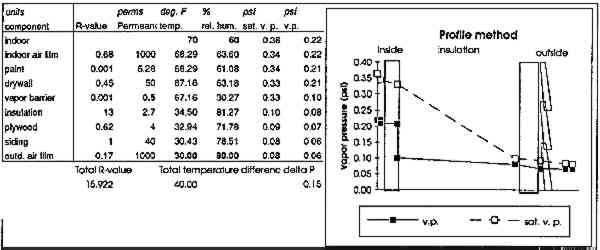EFFECTS OF CLIMATE CONTROL ON THE MUSEUM BUILDING ENVELOPEWILLIAM ROSE
2 PROFILING ANALYSISMost design of building envelopes, including museum building envelopes, is based on the American Society of Heating Refrigeration and Air Conditioning Engineers profiling method of envelope analysis (ASHRAE 1989)(fig. 1). Using this technique, a designer applies the following steps:
If the profile lines cross, methods are available to estimate the quantity of condensation. This method assumes heat transfer is by conduction and vapor transport is by diffusion. This technique produces information about the likelihood of moisture condensation, and, if pursued at length, the quantities of condensation can be calculated. This technique is based on sound physical theory, of course, but it contains several simplifying assumptions that limit its usefulness. This technique assumes that:
In the last several years, these assumptions have been called into question. The profiling technique often gives results that do not square with actual findings when it is applied to wall and roof construction that contains air cavities. Many researchers have shown that moisture movement in cavity walls and roof systems is by air movement or convection rather than by diffusion (Hutcheon 1959). The convection and radiation components of heat transfer are significant in building assemblies that contain cavities. Permeance values are not known with accuracy (Toas 1989), and they are variable, particularly with moisture content changes. Burch (1992) showed that permeability increases exponentially with relative humidity. There is so much moisture stored in a wood or brick wall that it may require several weeks or months for the wall to reach equilibrium with the surrounding conditions. In short, designers should not rely solely on standard profiling techniques when trying to predict the effect of changing indoor conditions on a building assembly. An advanced investigation of the hygrothermal performance of buildings requires a review of the physics involved. |
